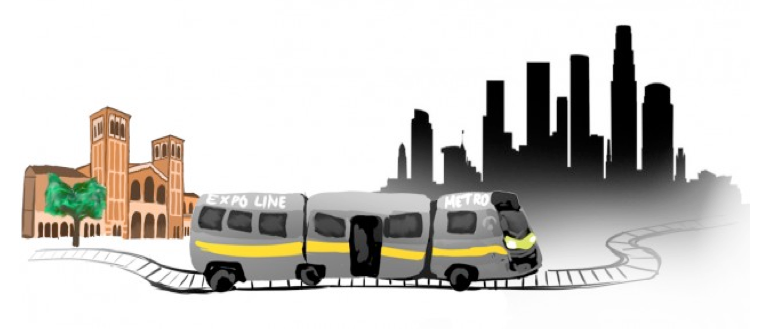CommentsGUEST COMMENTARY--There was one heck of a birthday party Friday. After years of bated breath, the LA County Metropolitan Transportation Authority finally opened its 6.6 mile, $1.5 billion Expo line light-rail extension, which stretches westward from its previous Culver City terminus all the way to Santa Monica. Adding to the hype, there were a host of celebrations near the new Santa Monica stations and a full day of free rides.
But after the crowds clear, the confetti is swept up, people will have to pay full price for train fares again. We’re still going to have an extended train track. In fact, if Metro stays on track – no pun intended – to complete the decades’ worth of projects it has planned, Angelenos will have a pretty extensive rail system by 2040.
It’s great that Metro’s push to get Angelenos out of their cars is finally leaving the station, so to speak. But there’s a caveat: Transit systems cost serious money to build and maintain. The Metro expects to drop $410 million on maintenance and security in 2017, an 8.6 percent increase from this year.
Fortunately, they’re looking for more money to fund these projects and improvements. To this end, the Metro’s Board of Directors is working on a draft plan for a referendum to go on November’s ballot. The referendum proposes to extend half-cent Measure R sales tax approved in 2008 for at least 20 years and introduce another half-cent sales tax, Measure R2, to take effect for 45 years. If all goes according to plan, the Metro will end up with $120 billion in extra cash.
Los Angeles voters need to approve Measure R2 in November if they want to see further improvements in their transit system’s accessibility and reliability. But first, the Metro needs to amend its expenditure plan and make sure it uses its money for the benefit of as many Southlanders as possible, not just the ones who live and work near rail corridors.
To that end, Metro needs to reach more potential riders by allocating more funds toward pedestrian, biking and bus infrastructure, as well as maintenance to ensure that their system is fast and reliable. That would come at a cost, namely a lesser emphasis on new rail construction.
Hopefully the transit gods will forgive me for saying that, but it’s no secret that rail projects are costly and take a long time to complete. Just look at the Expo line extension. Even when they’re done, they primarily serve corridors of high-density, high-wealth development. This is all well and good; trains serve these areas well.
But Los Angeles is a diverse place, and rail wouldn’t be the most effective option for all of its areas. Anyone familiar with my Metro columns knows that I’m big on buses and multimodal transportation as ways to reach people in lower density areas who wouldn’t otherwise utilize public transportation.
Case in point: Santa Clarita Valley residents recently voiced concerns about the returns their community would receive under the current iteration of Measure R2. San Fernando Valley leaders have shared similar sentiments about the attention their communities would receive. Lower density suburban communities like these would benefit more from bicycle and pedestrian paths and improved bus infrastructure. These projects would be faster, easier and cheaper to implement than rail and would have a wider reach.
For example, the Wilshire Bus Rapid Transit corridor, completed in 2010, runs through one of the busiest and most congested corridors in the city. And yet it only cost $31.5 million to install, a fraction of what the Expo extension cost.
But try telling that to Metro. A full 35 percent, or $42 billion, of Measure R2 is currently earmarked for major rail construction projects. By comparison, only 4.5 percent, or $5.4 billion, is going toward street improvements and biking infrastructure, with another 1 percent allocated for bike paths along the LA River. Bus system extensions are only getting $350 million. That’s chump change. Let’s say that Metro reallocates $2 billion away from rail construction and gives an extra billion each for multimodal and bus expansions. That adds up to $7.75 billion, or 6.5 percent of the total sales tax revenue.
In the shadow of big rail, that’s still chump change, but the boosts to the non-rail transit system would be anything but trivial. The extra cash could go a long way in planning new bus routes, improving street and fleet maintenance, improving the convenience and reliability of bus service and establishing more bike and pedestrian friendly infrastructure.
So yes, rail systems are a worthy investment for the more urbanized areas of LA, and you can bet that I’ll be living it up at the Expo extension’s grand opening. But when that shiny new rail line starts to lose its luster, Angelenos still need a fast, reliable and convenient way to get around the city. Measure R2 can give them the option they need. But first, Metro needs to change its track.
(Chris Campbell writes for the Daily Bruin where this was originally posted.) Illustration: Annie Chan/ Daily Bruin. Prepped for CityWatch by Linda Abrams.
Sidebar

 CityWatch Los Angeles
Politics. Perspective. Participation.
CityWatch Los Angeles
Politics. Perspective. Participation.
15
Wed, Jan















